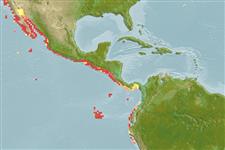Common names from other countries
Teleostei (teleosts) >
Perciformes/Serranoidei (Groupers) >
Anthiadidae (Fairy basslets or Streamer basses)
Etymology: Pronotogrammus: Greek, pro = first, in front of + Greek, noton = back + Greek, gramma = signal, letter (Ref. 45335).
More on author: Gill.
Environment: milieu / climate zone / depth range / distribution range
Ecology
Marine; demersal; depth range 40 - 200 m (Ref. 9342). Subtropical; 34°N - 9°S, 119°W - 78°W
Eastern Pacific: Los Angeles County in southern California, USA to northern Peru.
Size / Weight / Age
Maturity: Lm ? range ? - ? cm
Max length : 28.5 cm TL male/unsexed; (Ref. 86316)
Inhabits rough bottom, deep reefs. Feeds on small planktonic crustaceans (Ref. 2850).
Life cycle and mating behavior
Maturities | Reproduction | Spawnings | Egg(s) | Fecundities | Larvae
Robins, C.R., R.M. Bailey, C.E. Bond, J.R. Brooker, E.A. Lachner, R.N. Lea and W.B. Scott, 1991. Common and scientific names of fishes from the United States and Canada. Am. Fish. Soc. Spec. Publ. (20):183 p. (Ref. 3814)
IUCN Red List Status (Ref. 130435)
CITES (Ref. 128078)
Not Evaluated
Threat to humans
Harmless
Human uses
Fisheries: of no interest
Tools
Special reports
Download XML
Internet sources
Estimates based on models
Preferred temperature (Ref.
115969): 13.7 - 20.4, mean 15.4 (based on 36 cells).
Phylogenetic diversity index (Ref.
82804): PD
50 = 0.6250 [Uniqueness, from 0.5 = low to 2.0 = high].
Trophic level (Ref.
69278): 3.1 ±0.30 se; based on food items.
Resilience (Ref.
120179): Medium, minimum population doubling time 1.4 - 4.4 years (Preliminary K or Fecundity.).
Fishing Vulnerability (Ref.
59153): Low vulnerability (19 of 100).
